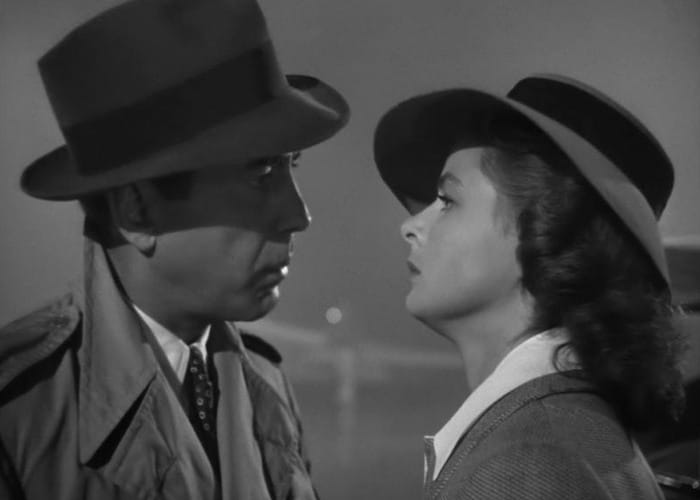Real Stories is a column about the true stories behind movies and TV shows. It’s that simple. This installment focuses on the true story and events surrounding the classic movie Casablanca.
You must remember this: Casablanca, the 1942 masterpiece directed by Michael Curtiz, is based on a true story. Set in the time in which it was filmed, the height of World War II, the movie centers on a place called Rick’s Café Américain, owned and operated by Rick Blaine (Humphrey Bogart).
Casablanca, the second largest city in Morocco, in Northern Africa, has become a hub for refugees seeking to flee Europe. But the city is controlled by Vichy France (the French State following the Nazi invasion), making it dangerous for enemies of the Axis powers to pass through. An American expatriate, Rick must navigate his mix of clientele and the various sides to which they belong.
Rick soon faces the ultimate test. One night, his former lover, Ilsa Lund (Ingrid Bergman), enters Rick’s. And she has a major problem. Her husband, Victor Laszlo (Paul Henreid), a major leader in the Czech resistance, must flee to the United States in order to continue the cause. Axis leaders are on his tail, and he needs Rick’s assistance. Victor and Ilsa ask Rick to help them obtain papers that will allow them to escape. But Rick still loves Ilsa. He must choose whether to help the cause and lose her or keep her by his side.
One of the many things that makes Casablanca such an achievement is the way it engaged with the events of its own time. And so, as we prepare to celebrate the 80th anniversary of the movie, here is a look at the true stories that informed the creation of Casablanca:
Refugees Begin Fleeing Europe
Casablanca takes its inspiration from a play co-written by Murray Bennett and Joan Alison titled Everybody Comes to Rick’s. In the summer of 1938, Bennett, then a 27-year-old English teacher in New York City, traveled to Vienna. At that time, the city was occupied by the Nazis, and Murray traveled there to assist Jewish relatives.
While there, he learned of the route refugees often took to arrive in America. Refugees often traveled from Marseilles to Morocco to Lisbon and then finally the United States. He returned from that trip, according to this New York Times obituary, with the basic premise for his play.
Two years later, in 1940, the Nazis invaded and conquered France. Fleeing Hitler’s empire, thousands of refugees made their way to places like Casablanca. In July of that year, more than 200 boats arrived in the ports of Casablanca. A majority of the refugees were Jewish. While there are of course many refugees in Michael Curtiz’s movie, Meredith Hindley notes in an essay for Longreads:
“The word ‘Jew’ is never uttered in the film. For all the clues to the characters’ nationalities the film provides, the fact the refugees who congregate at Rick’s might have come to Casablanca to evade Nazi Germany’s anti-Semitic policies is never acknowledged.”
Hindley notes that there were very few Americans in Casablanca at the time. However, the American consulate there did become a hub for refugees, noting it was “probably the closest thing to Rick’s.”
The Real Refugees in Casablanca
Not only does Casablanca depict the real crises of its time, but many members of the cast were, themselves, immigrants and refugees. According to film scholar Noah Isenberg (via Dallas Morning News), almost all of the movie’s roughly 75-person cast were immigrants. Of the 14 who earned a screen credit, only three were born in the United States.
As reported by the Canadian Broadcasting Corporation, some of the actors knew first-hand the evil of the Nazis and the war in Europe. S.Z. Sakall, a Jewish-Hungarian actor who plays the waiter Carl, fled Germany in 1939 and had three sisters die in a concentration camp. Helmut Dantine, who plays a Bulgarian roulette player, spent time in a concentration camp before he went free and left Europe. And actors Conrad Veidt (Major Heinrich Strasser) and Curt Bois (pickpocket), who was Jewish, were both German refugees. Curtiz himself was a Jewish-Hungarian immigrant, and he had many family members who were refugees from the Nazis.
According to one account from the set, during the famous scene when the cast sings “La Marseillaise,” actors began to cry as they reflected on the fight against fascism that existed on- and off-screen.
Real Events That Fueled Interest in the Movie
Warner Bros. planned to release Casablanca in 1943, but the premiere was moved up due to latest real-world events.
In 1942, Allied forces, under the command of General Dwight D. Eisenhower, launched Operation Torch to secure Northern Africa. The mission included the bombing of Casablanca. Allied forces secured the area as a means to begin their assault on the Axis powers in Southern Europe. To coincide with these real events and drive interest in the movie, Casablanca premiered at the Hollywood Theater in New York City on November 26, 1942.
In January, the Moroccan city hosted the Casablanca Conference. In attendance were a number of Allied leaders, including Franklin D. Roosevelt and Winston Churchill. Joseph Stalin declined to attend due to an ongoing offensive by the Soviets against the Nazis. At the conference, Roosevelt and Churchill promised unconditional surrender and “the destruction of the philosophies in those countries which are based on conquest and the subjugation of other people.”
Casablanca entered wide-release on January 23, 1943, to coincide with the end of the conference on January 24. At the time of its release, Variety predicted the movie “will take the [box office] of America just as swiftly and certainly as the [Allied forces] took North Africa.”
Remember that the next time someone complains about modern movies being too political.

